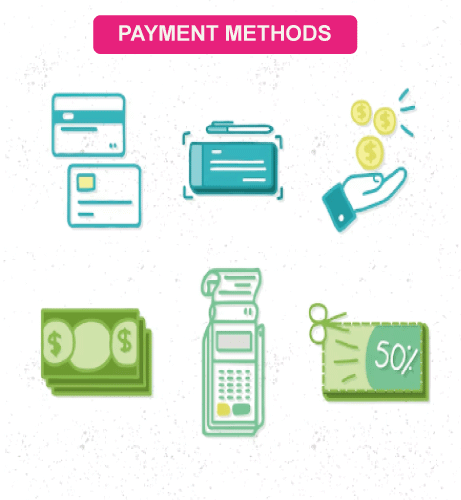Difference Between Flexible and Rigid PaymentIn a world full of online or offline payments, flexibility and rigidity are the two primary concepts that often determine the success or failure of a particular transaction. Flexible payment is a type of payment that refers to a payment method that is adaptable to various needs and circumstances of the customer. On the other hand, rigid payments refer to a fixed method that is not easily changed or modified according to the client's requirements. Both these modes of payment have their own benefits and drawbacks, and understanding the differences between them is critical to take an informed decision about which payment method will best suit your situation. 
Difference TableTo have a brief discussion about the difference between flexible and rigid payment, let us have a look at the difference table that indicates the difference pointers between the two most popular payment methods:
ControlFlexible payments give users more control over their payment options. Here is an example that will help you understand this concept better: in a flexible payment, the user can choose from various payment methods like credit cards, debit cards, bank transfers, and e-wallets. The consumer can also adjust the payment amount to suit their needs and circumstances. Whereas in rigid payments, there is less control over payment options. The user may only be able to use one payment method, like a credit card, and the payment amount will be fixed. 
Payment AmountFlexible payment allows the customer to adjust the payment amount as per their own requirement. If a user wants to pay a bill but has only money to pay half the amount, they can make a partial payment and pay the remaining amount later. On the other hand, rigid payments have a fixed payment amount that cannot be adjusted in any circumstances term if a user has to pay a bill for $100, they must pay the entire amount in one go. TimingIn flexible payments, the customer can get flexible timing to make the payment users can schedule a payment in advance, set up recurring payments, or delay payments if necessary. On the other hand, rigid payments have a fixed payment timing that cannot be adjusted in any circumstances. If a user needs to pay a bill on the first of every month, they must pay the bill on that date itself; otherwise, they may be charged a late fee. Transaction FeesIn inflexible payments, the consumer gets an offer to pay the transaction fee in a negotiable manner. For example, users can negotiate lower fees or tools to use a payment method with lower fees. On the other hand, rigid payments have fixed transaction fees that cannot be negotiated. Ease of UseWe can see that flexible payment options are more user-friendly and intuitive. Customers can easily switch between payment methods or adjust the payment amount using an online platform. Whereas in the case of rigid payments, it can be less user-friendly and intuitive, especially for users who are not familiar with other payment methods. 
CustomizationFlexible payments can be customized according to the needs of the client. A user has a chance to choose from various payment plans or payment schedules. In the case of rigid payments, there is less customization as the payment method, and the terms of the payment are fixed. Flexible payment options may also allow the user to choose from a range of payment methods that include of e-wallets, bank transfers, and credit cards due to this facility it give a chance to user with greater flexibility and convenience, as they can choose amongst various payment methods that are suitable according to their circumstances. On the other hand, in the case of rigid payments, the mode of payment is fixed according to the 3rd party. Whereas rigid payment options certainly offer less customization. This happens because the payment method and the payment terms are predetermined. For example, a user may only be able to pay for a product or service using a credit card or may have to pay a lump sum upfront. Through this, the user will be blocking the limited options provided to them, which may not align with their defined preferences. We can say that customization is a vital factor to consider while we are rolling between flexible and rigid payment options. Generally, Flexible Payment options are more preferred by the customers as it offers a good amount of customization, which eventually allows the users to choose the payment methods and terms that align with their comfortable preferences. Flexible Payment options can lead to a more positive user experience and happy and satisfied customers. On the other hand, Rigid payment options, as the word says, may offer less or "rigid" customization, limiting the options available to users and potentially leading to a less positive user experience. RiskRisk is a part of payment and comes with many payment options, and flexible payment options are one of the major carriers of risk factors. Flexible payments may carry a higher risk of fraud or errors. Let us understand this with an example- If a user is not careful when entering payment information, they may unintentionally make a payment to the wrong person. When we have a look at Rigid payments, it carries less risk of fraud or errors, as the payment terms are fixed and cannot be easily changed, and the person may also become stress and tension free by opting rigid payment option. AccessibilityWhen it comes to accessibility, flexible payments are more accessible to a wide number of users. For example, users who do not have access to a credit card may be able to use an e-wallet or bank transfer instead. On the other hand, rigid payment may be less accessible to some users who do not have methods like online banking or may not carry the required bank cards to make their payments. It is one of the most vital factors that the client should consider while rolling between rigid and flexible payment options. It is crucial to note down that not all the clients may get an access to the same payment methods, and their accessibility scenario may depend upon the factors like- location, economic status, and on personal preferences. As we have had a brief discussion about the differences between the flexible and rigid payment options depending on the various factors, to understand the concept in a detailed way, we will now have a closer look at the key pointers that the customer should keep in mind while deciding between the payment method that they should choose while they are stuck in a certain situation. 
Consider the needs and circumstances of the user: When the client is deciding which payment factor they should go with, they should have a deep inside about their needs and circumstances. If the user has to pay a bill but doesn't have enough money to pay the whole amount in one go, then they should go for flexible payment method. Consider the level of control needed: If the client is in need of having a control over their payment options, it is always recommended to go for flexible payment methods, and if the user is comfortable to have no control over their payment options, then they should go for rigid payment options. Consider the level of risk: It is vital to note that, if the customer is going for flexible payment methods, there are high chances of getting stuck in a fraud or face certain errors. Customers should take appropriate measures to protect their payment information that comes up on the screen once the payment is done. Consider the level of customization needed: If the customer has a requirement for customization to meet their specific needs and comfort, it is always recommended to go with the flexible payment method. On the other hand, if the user is comfortable with a predetermined payment method, a rigid payment method may be sufficient. Consider the level of accessibility needed: If the customer does not have access to a particular payment method, it is recommended to go for a flexible payment method as it offers alternative payment options. On the other hand, if the user has access to the required payment method, a rigid payment method may be sufficient. ConclusionBoth payment methods, i.e., rigid, and flexible, have their own sought of drawbacks and benefits. It is vital to understand the difference between the two so that the customers can make the right decision and an important decision about which payment method to use in different situations. By considering the needs and circumstances of the user, the level of control, risk, customization, and accessibility needed, users can choose the payment method that best meets their requirements and side by side ensures comfort. Whether you prefer a flexible payment method that offers more options and control, or a rigid payment method that is fixed and predictable, there is a payment method out there that can meet your needs.
Next TopicDifference between
|
 For Videos Join Our Youtube Channel: Join Now
For Videos Join Our Youtube Channel: Join Now
Feedback
- Send your Feedback to [email protected]
Help Others, Please Share










